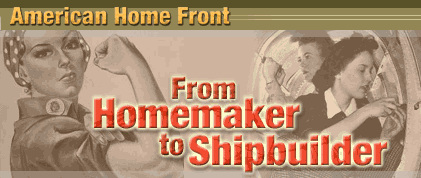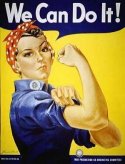



After the unbearable unemployment of the Great Depression, World War II brought a glut of high-paying manufacturing jobs. So much new production was needed to support that war effort that there was a gross shortage of manpower to staff factories and manufacturing plants. As a result, propaganda was distributed through print, film and radio to encourage women to take over their jobs for the duration of the war. There was a catch, however. When the war was over, they were supposed to give the jobs right back.
Women who had been employed in fields predominated by women- pink collar secretarial positions, domestic jobs and lower paying industrial positions were eager to try their hands at the new opportunities. Soon they were successfully doing things only men had done before. Women became taxi and streetcar drivers, operated heavy construction machinery, worked in lumber and steel mills, unloaded freight, built dirigibles, made munitions and much more. Men's jobs always paid more, and this was women's only chance to step up and earn more.
"Daddy, what did you do in the war?" was a popular question for soldiers coming back from our nation's battles, but World War II added a whole new concept - "Mommy, what did you do in the war?" Rosie the Riveter represented the new possibilities fo r women to pursue an economic livelihood outside the home and a means to support the war effort.
In 1942, Westinghouse Company's War Production Coordinating Committee created a series of posters to encourage support for the war effort. One of these posters became the 'We Can Do It' poster. This image was based on a United Press International wire service photograph taken of Ann Arbor, Michigan, factory worker Geraldine Hoff who worked as a metal-stamping machine operator. In later years, this image would be associated with the Rosie the Riveter legend, however this image only appeared for a few weeks to Westinghouse employees in the Midwest in 1943. An Ordnance Department Women Ordnance Worker (WOW) bandana is clearly visible on her head. This image has largely replaced the Norman Rockwell's image of Rosie the Riveter.Norman Rockwell's image of Rosie the Riveter received mass distribution on the cover of the Saturday Evening Post on Memorial Day, May 29, 1943. This image became very popular and was used throughout the war in war bond drives. To the WWII generation, this image embodied Rosie the Riveter. The 'We Can Do It' image only became the common image in the 1980s.
The slogan, "Do the job he left behind" said a lot. She could do it as long as he didn't want it or wasn't around to do it. As soon as soldiers began to return home, women were forced out of these jobs, even if they had no other means of support. A great many women would have preferred to stay in their industrial jobs, but the influx of men and the attitudes of the day prevented it.
With this glut of work and a dearth of employees, America's women were suddenly thrust into unfamiliar work. For years women had been limited to sewing clothing, painting faces on watches and other low-paying jobs in light-manufacturing. Convincing America that women could handle heavy work like riveting aircraft cowls, welding personnel carriers and building military equipment became a huge public relations project. And the women did it. In Richmond, California, they worked through racism and sexism to construct 747 ships during the war here is a feat not equaled anywhere else in the world, before or since.[7 Today, the park's Rosie memorial is located on the former grounds of Shipyard No. 2. Shipyard No. 3 is listed on the National Register of Historic Places.
Rosie was not just another poster girl. She was the real thing. She was working as a riveter building B-29 and B-24 airplanes at the Willow Run Aircraft Factory in Ypsilanti, Mich., when she was discovered" by Walter Pidgeon, the actor. Because she fit the image of the Kay Kyser hit song, "Rosie the Riveter", she was selected to appear in a short film that promoted war bonds throughout the nation's theaters.
Despite the way they were discarded at the end of the war, these female workers, symbolized by Rosie, had much to do with the success of the United States during World War II and their contribution should not be forgotten. In a very direct way, women helped win the war. Read the following account of one woman, below, who moved into the defense industry during WW2.
When the war started, I was twenty-six, unmarried, and working as a cosmetic clerk in a drug store in Los Angeles. I was running the whole department, handling the inventory and all that. It seemed asinine though to be selling lipstick when the country was at war. I felt that I was capable of doing something more than that toward the war effort.
There was also a big difference between my salary and those in defense work. I was making something like twenty-two, twenty-four dollars a week in the drugstore. You could earn a much greater amount of money in defense plants. Also it interested me. There was a certain curiosity about meeting that kind of challenge and here was an opportunity to do that, for there were more and more openings for women.
So I went to two or three plants and took their tests. And they all told me I had absolutely no mechanical ability. I said, I don't believe that. So I went to another plant, A.D.E.L. I was interviewed and got the job. This particular plant made the hydraulic value system for the B-17. And where did they put women? In the burr room. You sat at a workbench, which was essentially like a picnic table with a bunch of other women, and you worked grinding and sanding machine parts to make them smooth. That's what you did all day long. It was very mechanical and it was very boring. There were about thirty women in the burr room, and it was like being in a beauty shop every day. I couldn't stand the inane talk. So when they asked me if I would like to work someplace else in the shop, I said I very much would.
They started training me. I went to a blueprint class and learned how to use a micrometer and how to drawtools out of the tool crib and everything else. Then one day they said, Okay, How would you like to go into the machine shop?
I said, Terrific.
And they said, Now, Adele, it's going to be a real challenge because you'll be the only woman in the machine shop. I thought to myself, Well, that's going to be fun, all those guys and Adele in the machine shop. So the foreman took me over there. It was a big room, with a high ceiling and fluorescent lights, and it was very noisy. I walked in there, in my overalls, and suddenly all the machines stopped and every guy in the shop just turned around and looked at me. It took, I think, two weeks before anyone even talked to me. The discrimination was indescribable. They wanted to kill me.
My attitude was, Okay, you bastard, I'm going to prove to you I can do anything you can do, and maybe better than some of you. And that's exactly the way it turned out. I used to do the rework on the pieces that every guy on the shift before me had screwed up. I finally got assigned to nothing but rework.
Later they taught me how to run an automatic screwing machine. It's a big mother, and it took a lot of strength to throw that thing into gear. They probably thought I wasn't going to be able to do it. But I was determined to succeed. As a matter of fact, I developed the most fantastic biceps from throwing that machine into gear. Even today, I still have a little of that muscle left.
Anyway, eventually some of the men became very friendly, particularly the older ones in their late forties and fifties. They were journeymen tool and die makers and were so skilled that they could work anywhere at very high salaries. They were sort of fatherly, protective. They weren't threatened by me. The younger men, I think, were.
Our plant was an open shop, and the International Association of Machinists was trying to unionize the workers. I joined them and worked to try to get the union the plant. I proselytized for the union during our lunch hour. And you don't pay me for my lunch hour so that time doesn't belong to you, so you can't tell me what to do. And they backed down.
I had one experience at the plant that really made me work for the union. One day while I was burning I had an accident and ripped some cartilage out of my hand. It wasn't serious but it looked kind of messy. They had to take me over to the hospital to get my hand sutured. I came back and couldn't work for a day or two because my hand was all bandaged. It wasn't serious, but it was awkward. When I got my paycheck, I saw that they had docked me for the time that I was in the industrial hospital. When I saw that, I was really mad.
It's ironic that when the union finally got into the plant, they had transferred me out. They were anxious to get rid of me because after we got them in, I went to a few meetings and complained about it being a Jim Crow union. So they arranged for me to have a higher rating instead of a worker's rating. This allowed me to make twenty-five cents an hour more, and I got transferred to another plant. By this time, I was married. When I became pregnant, I worked for about another three months more, then I quit.
For me, Defense work was the beginning of my emancipation as woman. For the first time in my life, I found out that I could do something with my hands besides bake a pie. I found out that I had a manual dexterity and the mentality to read blueprints and gauges, and to be inquisitive enough about things to develop skills other than the conventional roles that women had at that time. I had the consciousness-raising experience of being the only woman in this machine shop and having the mantle of challenge laid down by the men, which stimulated my competitiveness and forced me to prove myself. This, plus working in the union, gave me a lot of self-confidence.
 The most famous effort in this project is the poster to the right of Rosie the Riveter. Women who worked the factories became known as Rosies, easily identifiable by her blue-jean overalls, red bandana and big attitude. She has rolled back the sleeve of her blue coverall to expose a flexed bicep. The expression on her face was confident and determined. The caption above her head reads, "We Can Do It!" in bold letters. Her image remains recognizable even today as a symbol of American strength and womanhood.
The most famous effort in this project is the poster to the right of Rosie the Riveter. Women who worked the factories became known as Rosies, easily identifiable by her blue-jean overalls, red bandana and big attitude. She has rolled back the sleeve of her blue coverall to expose a flexed bicep. The expression on her face was confident and determined. The caption above her head reads, "We Can Do It!" in bold letters. Her image remains recognizable even today as a symbol of American strength and womanhood.